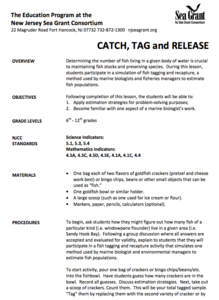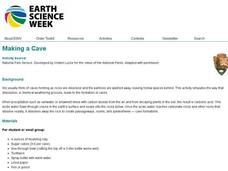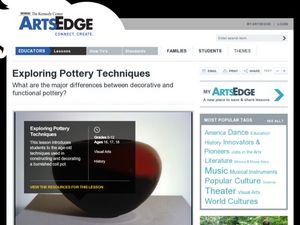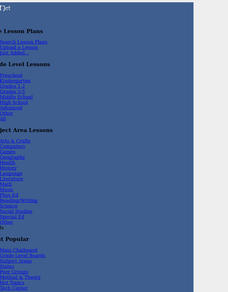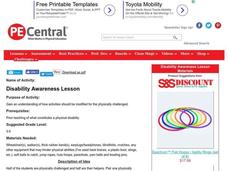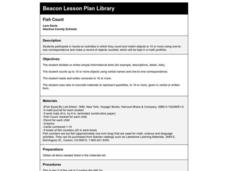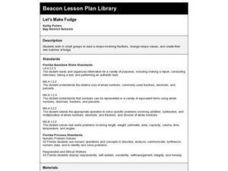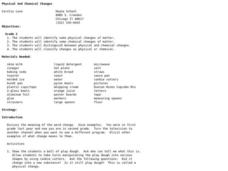Curated OER
Edible Color Wheels
Students create an edible color wheel using cookies and frosting. They mix tints into frosting to simulate the color of the color wheel.
Curated OER
I've Got That Sinking Feeling
Young scholars design a simple boat and predict how much weight it can carry. They should also discover why objects float or sink and how this can be determined experimentally. A great lesson on buoyancy!
Curated OER
Change It
Fourth graders expand their knowledge about how the physical properties of a substances can be changed. They are given multiple opportunities, using first-hand experiences and familiar objects in different contexts, to identify...
Curated OER
Catch, Tag, and Release
Learners discover how fish tagging is used by marine biologists and fisheries to estimate fish populations. Participating in a simulation, students use estimation to determine the whole population from a small number of items.
Curated OER
The Article II
In this grammar worksheet, students practice using expressions of quantity in a variety of assignments associated with thirty-six sentences.
Curated OER
Alchemists' Theory of the Elements
In this alchemy instructional activity, students read about the early thoughts of alchemists regarding elements. Students are given an experiment done by an alchemist during the Middle Ages and they answer three questions about the...
Curated OER
Warm Air versus Cold Air
Learners discover that warm air takes up more space than cold air. In this science lesson, students perform 4 experiments using balloons to determine that the molecules of warm air are more spread out than those of cold air.
Curated OER
Use Your Nose
Students explore how their senses work. In this senses lesson, students use the sense of smell to observe various spices. Students discuss their findings.
Curated OER
Making a Cave
Students discuss caves. In this science lesson, students experiment with how dissolution, a chemical weathering process, leads to the formation of caves. Once the cave is finsihed students draw a picture or describe in writing what it...
Curated OER
NYC Muslim Community Center: Why there? Why not?
Students examine religious diversity issues. In this current events lesson, students read the provided articles "Sacred Ground or Bridging a Cultural Divide?" "Multiple Views of the Proposed Muslim Center," and "Protests, a Bonfire, and...
Curated OER
Exploring Pottery Techniques
High schoolers examine Native American pottery. In this visual arts instructional activity, students analyze burnished and glazed clay pots. High schoolers study how to create pots from online sources and respond to questions about the...
Curated OER
The Water Cycle
Learners simulate the water cycle. In this water cycle lesson, students create a model of the water cycle. Learners draw the water cycle and write a paragraph explaining their drawing.
Curated OER
The Tobacco Time Bomb: What's In A Cigarette?
In this enlightening and disturbing health lesson, students read and discuss information on smoking and closely-look at the ingredients in a cigarette. You will be amazed at the list of ingredients that are found in cigarettes. This...
Curated OER
Unraveling the Web
Students consider how a message might be traced along a complex network, then explore backbone maps as a basis for understanding the purpose and structure of the Internet.
Curated OER
Shapes
Students differentiate objects based on contrast in physical characteristics such as color, texture, size and shape. They also recognize and sort objects by color families.
Curated OER
Disability Awareness Lesson
Young scholars gain an understanding of how activities should be modified for the physically challenged.
Curated OER
We're Alike, We're Different!
Students compare a variety of people counters to determine how they're alike and different and then sort, classify and write about how they sort and classify people counters.
Curated OER
Fish Count
Students participate in hands-on activities in which they count and match objects to 10 or more using one-to-one correspondence and make a record of objects counted, which be kept in a math portfolio.
Curated OER
Let's Make Fudge
Students make fudge after reading fractional values in recipes and finding equivalent fractions to those presented in the recipes. They study measurement abbreviations.
Curated OER
Rock Hounds
Students receive a basis for understanding the three main classifications of rock: igneous, sedimentary and metamorphic. They engage in a hands-on activity designed to give them an appreciation for rocks and minerals.
Curated OER
Portrait Sculptures
Third graders identify characteristics that they have in common with animals. They create a self-portrait sculpture combining the body structures of different animals. They create the sculpture armature, plaster the armature, and then...
Curated OER
Art, Naturally
Learners read an online article which examine different works of art. They study how patterns and shapes found in nature influence art. Finally, they create original works of art and write artist's statements.
Curated OER
Physical And Chemical Changes
Second graders identify physical and chemical changes of matter. They distinguish between physical and chemical changes. They classify changes as physical or chemical.
Curated OER
California-Becoming an Agricultural and Insustrial Power
Fourth graders explain how California became an agricultural and industrial power. They trace the transformation of the California economy in its political and cultural development since the 1850's.
Other popular searches
- Bowling for Columbine
- Math Bowling
- Bowling Pins
- Bowling Skills
- Bowling Dust
- Bowling Scoring
- Bowling Techniques
- Bowling Alone
- Basic Skills in Bowling
- Bowling Activity
- Bowling Bingo
- Bowling Scores





